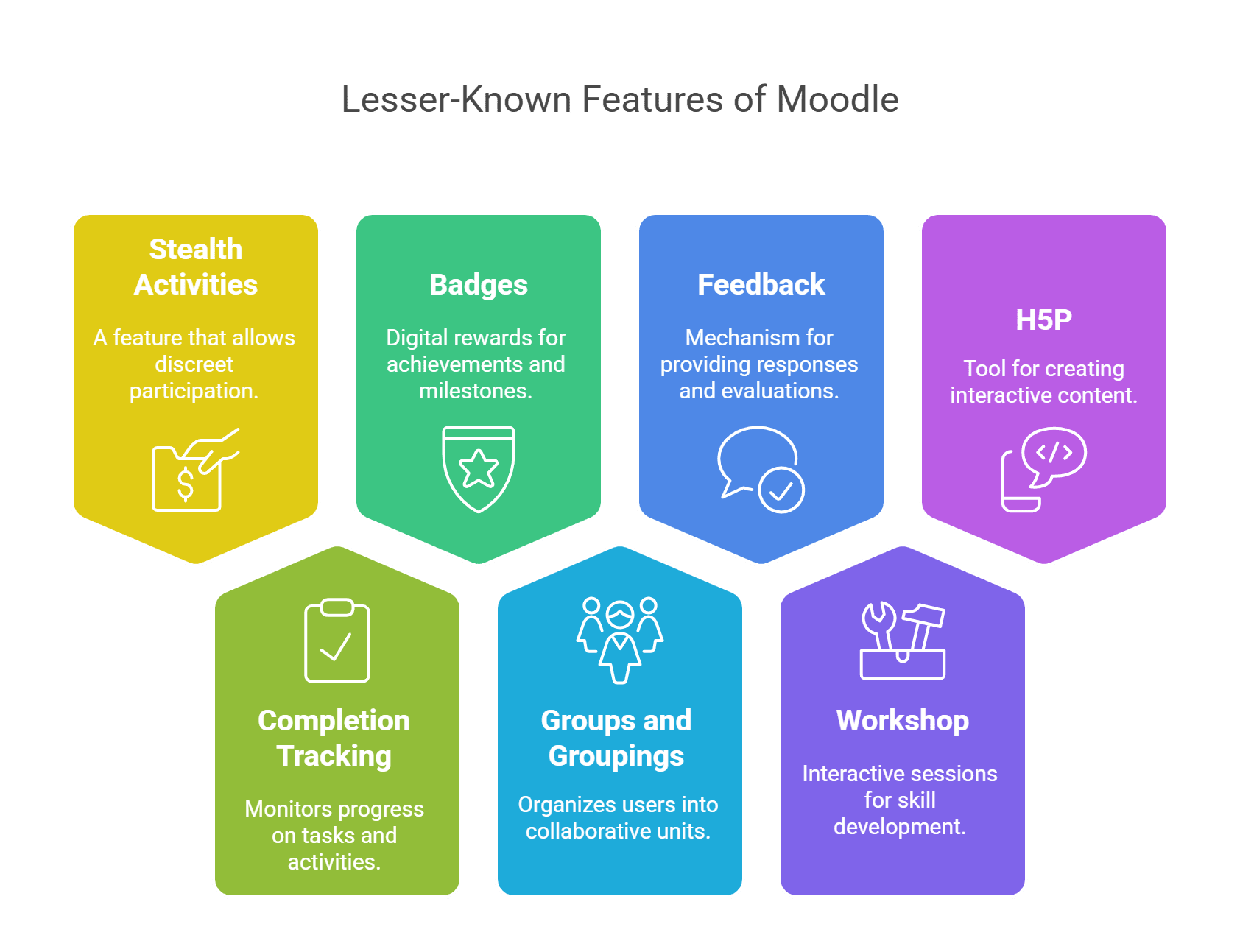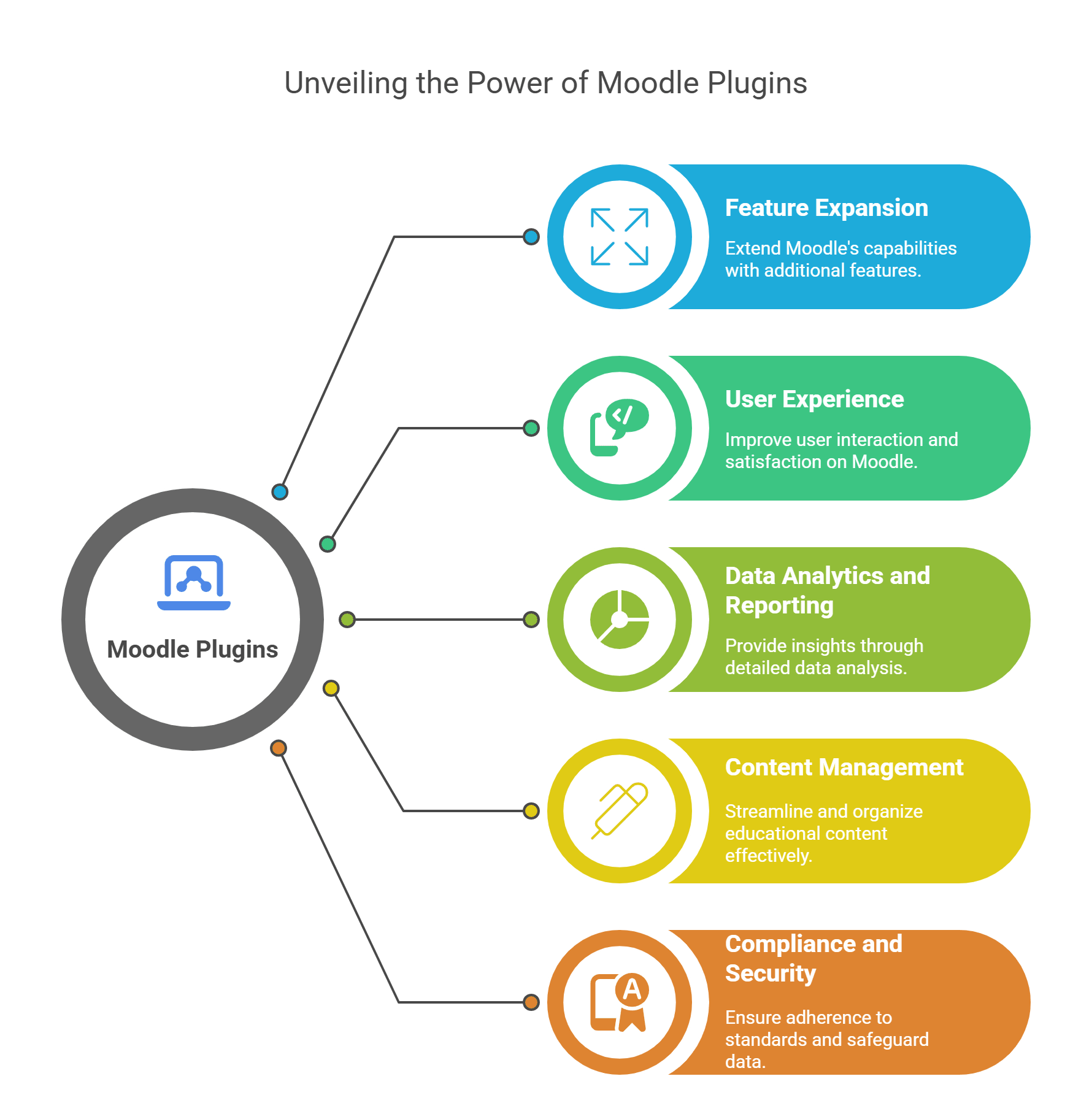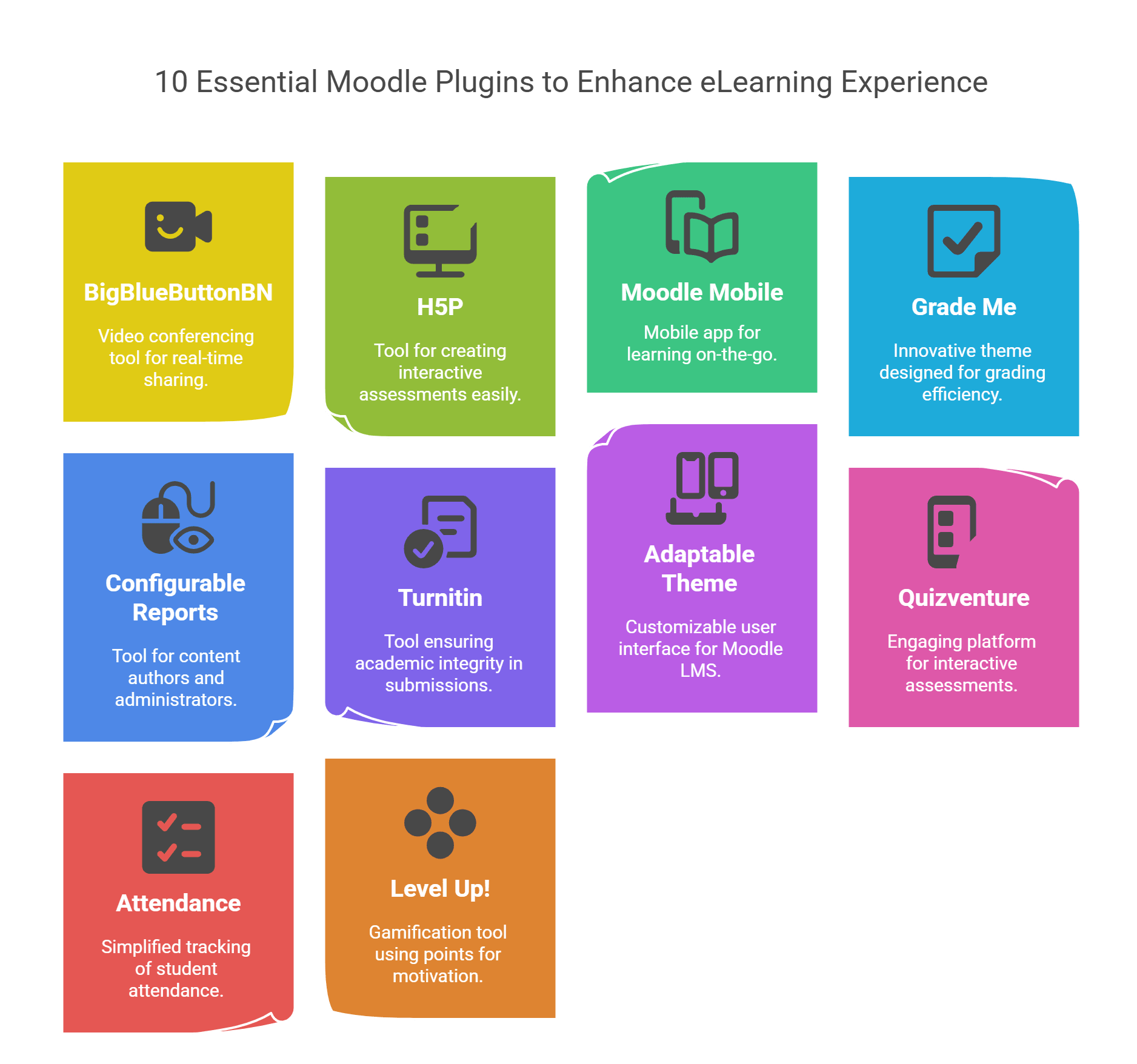
Moodle’s Best-Kept Secrets Features You Should Be Using!
Summary
Moodle’s offer powerful tools beyond its basic features. This guide uncovers hidden gems within Moodle and explores essential plugins that enhance eLearning experiences. From boosting engagement to improving course management, these tools help educators and institutions get the most out of their Moodle platform.
While Moodle’s reputation as a premier learning management system (LMS) is well-established, there are still untapped resources within its arsenal that could significantly elevate your e-learning endeavors.
With a massive user base spread across over 166,500 registered sites, Moodle’s versatility in creating and managing dynamic online courses is no secret. Yet, beyond the visible horizons of its robust features lies a treasure trove of underutilized tools.
These hidden gems aren’t just upgrades. They’re game-changers that will transform the Moodle experience for both teachers and students!
In this blog, we will reveal lesser-known features and plugins that will transform your approach to online education.
Table of Contents:
- What is Moodle?
- Top 7 Lesser-Known Features to Check Out
- Role of Plugins in eLearning Moodle
- What are the 10 Essential Moodle Plugins to Enhance Your eLearning Experience?
- BigBlueButtonBN: Video Conferencing and Real-Time Sharing
- H5P: Enabling Interactive Assessments
- Moodle Mobile: Make eLearning On-The-Go Possible
- Grade Me: A Revolutionary Moodle Theme for Grading
- Configurable Reports: The Best Content Authoring Tools for Admins
- Turnitin: Essential for Academic Integrity in eLearning Moodle
- Adaptable Theme: The User Interface Makes the Moodle LMS
- Quizventure: Beyond Multiple-Choice in Interactive Assessments
- Attendance: Keep Track Without the Hassle
- Level Up!: Points as Motivators in eLearning Solutions
- Conclusion
What is Moodle?
Moodle is a powerful, open-source Learning Management System (LMS) used by educators, institutions, and businesses worldwide to create engaging online learning experiences. Known for its flexibility and customization, Moodle supports interactive courses, assessments, and collaboration tools. With a vast library of plugins and features, it helps educators enhance learning and streamline course management.

Top 7 Lesser-Known Features to Check Out
Below are the top seven lesser-known features of Moodle that can transform your approach to online education:
1. Stealth Activities
In the field of course management, Moodle introduces the concept of Stealth Activities, a feature designed to streamline course presentations without sacrificing content accessibility.
This tool allows educators to curtail clutter on the course page, yielding a more refined and structured educational environment. Stealth Activities are essentially invisible to the user on the course page yet remain accessible through strategic navigation.
Stealth activities are activities or resources not shown on the course page but can still be accessed by students through direct links or conditional access settings.
To make an activity or resource stealth, you must edit its settings and set the “Visible” option to “Hide.” Next, you need to click on the eye icon next to the activity or resource name on the course page and confirm that you want to make it available but not shown on the course page. You can then create links to the stealth activity or resource in other places, such as labels, pages, or books.
2. Completion Tracking
If you want to track student progress in your course, this can be one of your best Moodle features.
Completion tracking allows you to set criteria for each activity or resource to mark it as complete in the Moodle Calendar. For example, you can set an activity to be completed when a student views it, submits it, receives a grade, or meets a certain condition.
You can also set course completion criteria based on the completion of certain activities or resources, grades, or manual self-completion.
To enable completion tracking, you need to go to your course settings and set the “Completion tracking” option to “Yes”. Then, you need to edit the settings of each activity or resource and set the “Completion tracking” option to either “Manual,” “Automatic,” or “Automatic, based on conditions.”
You and your students can then view the progress and completion status of each activity or resource and the whole course in various places, such as the course page, the dashboard, the grades report, or the completion report.
3. Badges
Badges are a feature that can be used to motivate and recognize your students’ achievements and participation in your course. These are digital awards that you can create and award to your students based on certain criteria.
For example, you can award badges for completing a course, passing a quiz, submitting an assignment, posting in a forum, or achieving a certain grade. You can also create badges with custom images, names, descriptions, criteria, and expiry dates.
To create and manage badges, you need to go to Course Administration> Badges. There, you can add new badges, edit existing badges, enable or disable badges, award badges manually or automatically, view issued badges, and manage badge settings.
Your students can view their earned badges in their profile or on their dashboard. They can also display their badges on their profile or export them to external backpack services.
4. Groups and Groupings
If you want to divide your students into different groups for different purposes, Moodle has a feature for that: groups and groupings.
Groups are collections of students that can be used to assign different activities or resources to different groups of students or to facilitate collaborative work among students.
On the other hand, groupings are collections of groups that can be used to restrict access to certain activities or resources based on the groups that belong to the grouping.
For example, you can create groups based on topics, levels, interests, roles, or preferences. You can also create groupings based on different scenarios, such as project work, peer review, differentiated learning, or blended learning.
To create and manage groups and groupings, you need to go to Course Administration> Users > Groups. Here, you can add new groups, edit existing groups, add or remove users from groups, import or export groups, and manage group settings.
You can also add new groupings, use editing tools for existing groupings, add or remove groups from groupings, and manage grouping settings.
5. Feedback
This Moodle feature helps create and conduct surveys, quizzes, or evaluations in your course. Feedback activity allows you to create and add custom questions and options for your students to answer.
You can use feedback for various purposes, such as gathering feedback from your students, conducting self-assessments, testing prior knowledge, collecting data for research, or evaluating learning outcomes.
To create and manage feedback, add a new feedback activity to your course and edit its settings. Here, you can set the name, description, availability, access, completion, and other options for your feedback.
You can also add questions to your feedback of various types, such as multiple-choice, short answer, numeric, scale, or text area. You can also view and analyze the feedback results in various formats, such as summary, analysis, responses, charts, or Excel export.
6. Workshop
Moodle has a feature for setting up peer assessment tasks in your course: workshop. Workshop activity allows you to define the assessment criteria and grading scale and allocate submissions for peer review.
Workshops can be used for various purposes, such as developing critical thinking skills, encouraging collaborative learning, providing formative feedback, or assessing learning outcomes.
To create and manage a workshop, add a new workshop activity to your course and edit its settings. Here, you can set the name, description, availability, access, completion, and other options for your workshop.
You can also set your workshop’s submission and assessment phases, either by using a manual switching mode or a scheduled allocation mode.
7. H5P
If you want to create and add interactive content to your course, H5P is the right Moodle feature for you. It is an activity that allows you to create and embed interactive content such as live engagement videos, presentations, games, quizzes, and more. H5P content is responsive and accessible and can enhance your students’ engagement and learning outcomes.
To create and manage H5P, add a new H5P activity to your course and edit its settings. Here, you can set the name, description, availability, access, completion, and other options for your H5P.
You can also choose from a variety of H5P content types, such as interactive video, course presentation, drag-and-drop, fill-in-the-blanks, memory game, or timeline.
If you want, you can customize the appearance and behavior of your H5P content, such as adding media files, texts, buttons, feedback, scores, or transitions. View and track the H5P results in various places, such as the grade book, the activity report, or the H5P report.

Role of Plugins in eLearning Moodle
When you log into Moodle, what you see on the screen is far from all there is. Moodle plugins amplify the basic Moodle setup, transforming it into a more versatile and powerful learning management system.
Below are the roles that plugins serve in enriching the eLearning experience on Moodle:
- Feature Expansion: Plugins add capabilities. Let’s take a grading, for instance. Moodle offers a basic grading system, but with plugins, you can implement more complex grading paradigms that could suit your specific educational model.
- User Experience: You’re not just adding features but improving how people interact with the platform. This is where user experience comes in. With the right plugins, navigating Moodle becomes simpler and more intuitive.
- Data Analytics and Reporting: What gets measured gets managed. While Moodle provides some basic data tracking, plugins can offer comprehensive analytics. This becomes a crucial asset for organizations relying on data-driven learner engagement strategies.
- Content Management: Organizing course material in Moodle can become cumbersome as your content library grows. Plugins come to the rescue, offering smart ways to manage and deploy various educational content.
- Compliance and Security: There are rules to follow when it comes to formal education or corporate training. Plugins can help ensure your Moodle setup meets compliance standards and security protocols.

What are the 10 Essential Moodle Plugins to Enhance Your eLearning Experience?
Below are the top 10 essential Moodle plugins that can significantly enhance your eLearning experience, making it more dynamic, efficient, and engaging:
1. BigBlueButtonBN: Video Conferencing and Real-Time Sharing
Video conferencing is no longer nice; it’s a necessity. BigBlueButtonBN offers a seamless integration with Moodle, enabling live video conferencing. With features like real-time sharing of slides, chat, and even a virtual whiteboard, BigBlueButtonBN takes remote learning to a new level.
- Real-Time Engagement: Encourages active participation through live video and chat functionalities.
- Whiteboard Features: Allows for real-time annotation, making it easier to explain complex topics.
2. H5P: Enabling Interactive Assessments
Assessment is a critical component of education. H5P takes Moodle’s assessment features further by introducing interactive quizzes, flashcards, and more.
- Variety of Assessment Types: Choose from multiple-choice questions, drag-and-drop, fill-in-the-blanks, and more.
- Interactive Content: Create engaging, interactive elements like videos and presentations that can be embedded into courses.
3. Moodle Mobile: Make eLearning On-The-Go Possible
As more learners prefer using mobile devices, a mobile-responsive Moodle platform is crucial. Moodle Mobile plugin makes your courses accessible on smartphones and tablets.
- Ease of Access: Access course material, participate in forums, and even take quizzes from your mobile device.
- Offline Access: Download course material and access it offline, making learning uninterrupted.
4. Grade Me: A Revolutionary Moodle Theme for Grading
Grading can often become cumbersome for educators. The Grade Me plugin streamlines this process, offering a simplified yet comprehensive grading system.
- Automated Grading: Set specific grading criteria and let the plugin do the rest.
- Feedback Integration: Attach feedback forms directly within the grading interface.
5. Configurable Reports: The Best Content Authoring Tools for Admins
Configurable Reports is a must-have for administrators who need to monitor course effectiveness and student engagement. It allows you to create custom reports that fit your institution’s unique needs.
- Customizable Reports: Create reports that focus on specific metrics, such as student performance or course engagement.
- Data Export: Easily export data for further analysis or for sharing with stakeholders.
6. Turnitin: Essential for Academic Integrity in eLearning Moodle
For educational institutions, Turnitin is almost as indispensable as the textbooks in the library. It brings two layers of value.
- Plagiarism Checks: Each piece of student-submitted work undergoes a meticulous scan against an extensive database that includes academic journals, countless essays, and other online content. It’s not just about flagging copied text but about upholding the integrity of the entire educational process.
- Feedback Studio: The Feedback Studio feature serves as an educational asset by providing actionable insights. It pinpoints structural and grammatical issues, giving students a roadmap for improvement.
7. Adaptable Theme: The User Interface Makes the Moodle LMS
Anyone who’s spent time on a poorly designed website knows how much of a relief a well-designed interface can be. Adaptable Theme gives Moodle that polished edge.
- Visual Customization: This is not a matter of slapping on a coat of paint. It’s about a thoughtful design process, aligning the Moodle interface with your organization’s look and feel.
- User-Fiendly Interface: It’s more than just a ‘Back’ and ‘Next’ button; it’s about logical navigation. The plugin enables the admin to strategically place features and buttons, reducing unnecessary clicks and scrolling for users.
8. Quizventure: Beyond Multiple-Choice in Interactive Assessments
Standard quizzes can feel like ticking boxes. Quizventure challenges this by elevating the interactive aspects of assessments.
- Engagement Boost: It’s not game-playing; it’s a cognitive approach to learning. Interactive quizzes require a different level of thinking, encouraging more meaningful interaction with the course material.
- Instant Feedback: This plugin provides real-time insights right after each question. It’s an academic feedback loop that allows for immediate understanding and retention.
9. Attendance: Keep Track Without the Hassle
Marking attendance in a digital setting is about more than a roll call. It’s a data point for understanding student engagement.
- Automated Tracking: This isn’t passive tracking; it’s a dynamic system that recognizes various forms of student engagement. Students log in, submit assignments, and participate in forums, all of which are logged.
- Customizable Parameters: The flexibility of this plugin lies in its customization. You set the benchmarks—be it forum participation, quiz submissions, or something else—that count as ‘attendance.’
10. Level Up!: Points as Motivators in eLearning Solutions
What motivates students to log in, participate, and, ultimately, learn? Level Up! tries to answer this by introducing a reward system into Moodle.
- Incentive Structure: It’s not just about accumulating points; it’s about what those points signify—engagement, improvement, and achievement. Points become more than numbers; they become markers of a student’s journey through the course.
- Leaderboards: The social aspect of learning comes into play here. By knowing where they stand among peers, students are motivated to outdo others and collaborate.
Conclusion
Moodle LMS is powerful and versatile and offers many features for online teaching and learning. However, many users may ignore or overlook some of these features.
If you want to enhance your online courses using Moodle, our team at Hurix Digital is here to assist you. We specialize in LTI content integration, customization, hosting, and maintenance of your Moodle platform. Whether you need to incorporate interactive content, video lectures, or assessments, we can streamline the LTI integration process.
Contact us today to discover how we can meet your LTI needs effectively!

Currently serving as the Vice President of Technology Delivery Operations at HurixDigital, a prominent global provider of digital content and technology solutions for publishers, corporations, and educational institutions. With over 16 years of experience spanning EdTech and various domains, I hold certification as a SCRUM Product Owner (CSPO). My expertise includes operations, finance, and adept people management skills.








